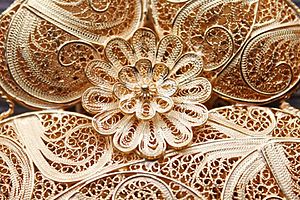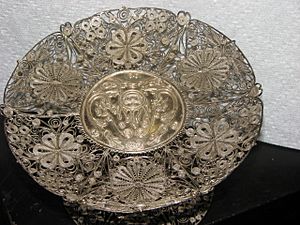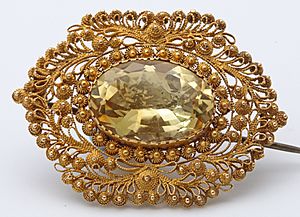Filigree facts for kids

Filigree is a special type of metal art. It's used to make beautiful jewelry and other small metal items.
Artists usually make filigree from gold and silver. They use tiny beads or twisted threads of metal. These pieces are carefully joined together to create amazing designs. It often looks like delicate lace. Filigree is still very popular in India and other parts of Asia. It was also well-liked in Italy, France, and Portugal from the 1600s to the late 1800s. Don't confuse filigree with 'ajoure' work. Ajoure involves drilling holes in flat metal, which is different.
The word "filigree" comes from older words. It combines the Latin words "filum" (meaning thread) and "granum" (meaning grain or small bead).
Contents
History
Filigree has been a part of jewelry making for a very long time. In the past, it was a common skill for jewelers. Ancient jewelers, like the Etruscans and Greeks, often built their gold jewelry by joining small pieces together. They didn't usually carve or engrave the metal.
Ancient Work
People have found filigree jewelry from ancient Mesopotamia that dates back to 3,000 BC. In the city of Midyat in Mardin Province, a special type of silver and gold filigree called "telkari" started in the 1400s. Even today, skilled artists in this area still make beautiful telkari pieces.
Ancient Egyptian jewelers used wire in their designs. They would lay it on a background or braid it. However, they didn't use a lot of filigree, except for chains. They were better known for their cloisonné work, which uses colored enamel. Many examples of round, braided gold chains, similar to those made in India today, have been found.
In jewelry from Phoenicia, like pieces found in Cyprus and Sardinia, gold wire patterns are laid very carefully on a gold surface. But the art of filigree became most perfect in ancient Greek and Etruscan work from the 6th to 3rd centuries BC. Many earrings and other ornaments from central Italy are now in museums like the Louvre and the British Museum. Most of these are made with filigree.
The Hermitage in Saint Petersburg has a large collection of Scythian jewelry. Many necklaces and bracelets in this collection are made from twisted wire. Some have up to seven rows of braids. Their clasps are shaped like animal heads. Other pieces are strings of large gold beads decorated with wire patterns soldered onto them.
Asia
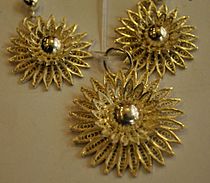

It's likely that filigree has been made in India, Iran, and parts of central Asia for a very long time. The designs have stayed mostly the same. Indian filigree artists still use the same patterns and methods as the ancient Greeks.
In Cuttack, a city in the eastern Indian state of Odisha, traditional filigree is called tarakasi. Most tarakasi work shows images of gods and goddesses. However, this art form is slowly disappearing. Silver filigree from Karimnagar in Telangana state is also well-known.
Medieval Europe
In medieval times, many religious objects like reliquaries (containers for holy relics) and book covers were made with filigree. These items were often made in Constantinople or in European monasteries. They were decorated with precious stones and enamels, and often had filigree designs. Large gold surfaces were sometimes covered with filigree scrolls. Examples of this can be seen in the Victoria and Albert Museum and the British Museum.
In northern Europe, the Saxons, Britons, and Celts were skilled goldsmiths. Amazing examples of filigree patterns on gold from Anglo-Saxon tombs are in the British Museum. The Staffordshire Hoard, a large collection of Anglo-Saxon gold and silver found in 2009, also has many examples of very fine filigree.
Irish filigree work from the Insular period is very detailed and varied. The Royal Irish Academy in Dublin has many reliquaries and jewels that use filigree. The famous Tara Brooch is a great example. Irish filigree often features complex knots and patterns. A long thread seems to appear and disappear, often ending in the head or tail of a serpent.
The reliquary holding the "Bell of Saint Patrick" is covered with many types of knotted filigree. A chalice called the "Ardagh Chalice", found in 1868, has incredibly fine filigree work.
Much medieval jewelry across Europe, up to the 1400s, used filigree for decorations. Silver filigree was also made by the Moors in Spain during the Middle Ages. They brought this skill to the whole Iberian Peninsula, and it then spread to Spanish colonies in America.
Filigree is still made in Italy, Portugal, Malta, North Macedonia, Albania, the Ionian Islands, and other parts of Greece. Greek filigree can be large, with many layers of wires and beads. These are often set with turquoise stones. They make rich headpieces, belts, and chest ornaments.
Silver filigree brooches and buttons are also made in Denmark, Norway, and Sweden.
Iberian Peninsula
The oldest filigree pieces found in the Iberian Peninsula are from 2000–2500 BC. Filigree began to be made in Portugal in the 700s when Arab people arrived, bringing new patterns. Over time, the Iberian Peninsula developed different filigree styles. While filigree became less common in Spain, it became very refined in Portugal. After the 1700s, Portuguese Filigree had its own unique look. Gold and silver filigree jewelry with delicate designs is still made in Portugal. Filigree hearts are famous symbols of Portuguese jewelry.
Africa
Filigree work was brought to Great Britain from Abyssinia after the Battle of Magdala. Items like armguards, slippers, and cups, some now in the Victoria and Albert Museum, were made of thin silver plates with wirework soldered on top.
How Filigree is Made and Used
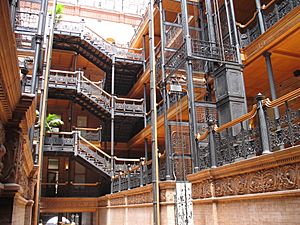
The art of filigree involves curling, twisting, and braiding thin, flexible metal threads. These threads are then joined where they touch each other, or to a metal background. This is done using a special powder called flux (like borax) and a blowpipe.
If tiny beads are needed, small pieces of metal wire or thin metal sheets are used. These are mixed with flux and placed in small holes in a charcoal block. Then, a blowpipe (or a blowtorch today) melts them. The metal bits curl up and form tiny, round beads. These small beads are often placed in the centers of spirals or at points where they will make the wirework look even better. Stronger wire is often used to create a frame that protects the more delicate filigree work.
Modern filigree items like Brooches, crosses, earrings, and buttons are usually surrounded by flat metal bands. These bands help the delicate filigree keep its shape.
Other Uses of "Filigree"
The word "filigree" is also used to describe other intricate designs. For example, large metalwork like wrought iron or cast iron railings and balustrades (staircase supports) can be called "filigree" if they have very detailed, ornamental patterns.
|
See also
 In Spanish: Filigrana (artesanía) para niños
In Spanish: Filigrana (artesanía) para niños


